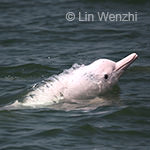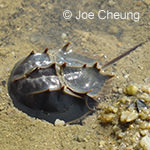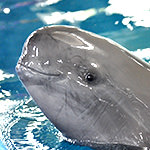

| Scientific Name: Hippocampus spp. Species found in Hong Kong: Hippocampus kuda (Yellow seahorse) Hippocampus trimaculatus (Three-spot seahorse) Hippocampus kelloggi (Great seahorse) |
| IUCN Conservation Status (Year Published): All seahorses - Listed in Appendix II of the Convention on International Trade in Endangered Species of Wild Fauna and Flora (CITES) 11 out of 54 seahorse species being classified as ‘Vulnerable' or ‘Endangered' Yellow seahorse – Vulnerable (1996, 2003 and 2014) |
| Life Span: Range from 1-5 years |
| Distribution: Shallow tropical and temperate waters throughout the world; especially in sheltered areas such as coral reefs or mangroves |
Seahorse is a type of fish – a small marine animal 2 to 35 cm in length. Their thin skin stretched over a series of bony plates, which are arranged in rights throughout the body. They also have a flexible and well-defined neck. Seahorses mainly feed on small crustaceans floating in the water or crawling on the bottom of the sea such as mysid shrimp.
Seahorses may court for several days before breeding. During this time, they may change colour, swim side by side holding tails or anchor to the same strand of sea grass with their tails and wheel around in unison in what is known as a "pre-dawn dance". They eventually engage in a "true courtship dance", during which the male pumps water through the egg pouch on his trunk which expands and opens to display its emptiness. When mating, the female seahorse deposits eggs inside the male's pouch. The male carries the eggs until the baby seahorses are fully developed. The number of young released by a male seahorse ranges from 100 to 200 on average, but it may be as few as 5 for smaller species, or as many as 1,500.
Like almost of the other fish species, seahorses do not nurture their young after birth. Infants are susceptible to predators or ocean currents which wash them away from feeding grounds or into temperatures too extreme for their delicate bodies. Thus, less than 0.5% of infants survive to adulthood.

Due to its unique appearance, seahorse is one of the most iconic species in the ocean. As an important predator on bottom-dwelling organisms, the decrease in their population or their extinction may disrupt the balance of ecosystems. Some of the seahorses' biological features and breeding behaviours make them susceptible to overfishing. For example, most seahorses appear to be monogamous within a single breeding cycle. Moreover, male seahorses carry eggs in their pouches until baby seahorses hatch, hence, the survivability of the young depends on that of the parent for much longer than most fish. If a pregnant male seahorse is caught, thousands of seahorse infants will fail to survive.
| Estimated Wild Population: Unknown |
International Union for Conservation of Nature (IUCN) Red List Conservation Status: Yellow seahorse - Vulnerable
EX
EW
CR
EN
VU
NT
LC
DD
All seahorses - |
 |
 |
 |
|---|---|---|
|
Overexploitation for Uses in Traditional Medicine
95% of the seahorses traded are used as traditional medicine |
Bycatch in Trawling Fisheries
As the mobility of seahorse is limited, it is easily bycaught by fisheries, especially trawling fisheries |
Loss or Degradation of Natural Habitats
The marine environment is affected by pollution and coastal development |

About
To conduct seahorse survey in the eastern waters of Hong Kong and tag suitable seahorses, with the aims to document the number, species diversity, size, sex, distribution, long-term survivorship and growth of seahorses in shallow coral communities and adjacent areas.
Objectives
Generate useful data to be shared with the government, other conservation groups and the general public, to help formulate effective conservation management plans.

The Foundation has been funding seahorse and coral reef research and conservation projects across Asia for many years, including monitoring the restoration progress of coral reefs and helping to provide community education, in order to protect seahorse and its habitats.
 |
 |
|---|---|
|
Say No to Seahorse Consumption! |
Join Friends of Foundation! Join and support our conservation efforts through monthly or one-off donation as our new "Friends of Foundation" member! |
 |
 |
|---|---|
|
Share Your Sightings! |
Become a Supporting Organization
|


